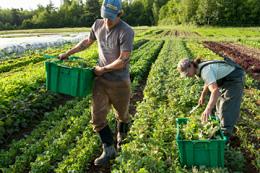Agriculture failures put Canadian farmers at risk

Commentary
By Sylvain Charlebois
Make no mistake, the real issue for Canada’s agri-food sector isn’t what’s happening in Washington – it’s what’s happening here at home.
While many Canadians worry about what the next four years might hold with President-elect Donald Trump’s return, the focus should be on whether Ottawa is doing enough to support our food security, supply management, and the well-being of our farmers.
For those concerned about the future of Canada’s agri-food sector, the reality may be less about doom and more about data-driven strategies to maintain competitiveness.
First, let’s examine food inflation during Trump’s first term. Back in 2016, when Trump was first elected, the political climate was similarly intense, with concerns about potential tariffs, renegotiated trade deals, and an America-first policy that could impact U.S. relations with Canada.
Upon taking office, Trump inherited a U.S. food inflation rate of minus four percent – a figure that might sound beneficial to consumers, but low food prices often discourage corporate investment and stall innovation in the industry. Over the course of his term, food inflation eventually rose to four percent but generally stayed manageable, averaging between 1.5 and 2.5 percent.
Despite widespread fears of tariffs on Canadian goods, no measures were imposed that disrupted Canada’s food supply chain, which proved resilient.
Then came the United States-Mexico-Canada Agreement (USMCA), Trump’s landmark trade deal, which reshaped commerce across North America. Ratified in 2020, Trump’s final year in office, this agreement led to a nearly 57 percent surge in Canada’s agri-food exports to the U.S., reaching almost $60 billion last year. Previously, under the Obama administration, approximately 48 percent of Canada’s agri-food exports went to the U.S. market, but today, nearly 60 percent of these exports flow south.
This heavy reliance on the U.S. market is both a blessing and a curse – while Canada’s agri-food sector benefits from access to the vast American market, it also leaves the economy more susceptible to shifts in U.S. policy. Well-known for his America-first approach, Trump is keenly aware of this dependency and has leveraged it in trade negotiations.
Trump’s policies drew Canada into a closer commercial relationship with the U.S., particularly in agri-food. During his first term, Trump also pressured Canada to make concessions on its supply management system, allowing increased U.S. access to Canadian markets for products like dairy. Recently, Canada’s Senate criticized Bill C-282, which would protect supply-managed sectors – including dairy, eggs, and poultry – in future trade deals. Critics warn that, if left intact, C-282 could turn supply management into an even bigger target for Trump’s administration.
But make no mistake, under a second Trump term, Canada will likely face additional pressure to grant more market access to American producers, and Canadian taxpayers may end up shouldering even larger subsidies for affected sectors. Supply management boards may frame these payments as “compensation” for potential losses, but in reality, they are subsidies that stem from necessary quota adjustments.
The larger challenge, however, lies in Canada’s ability to maintain a competitive agri-food sector. Trump’s second-term agenda promises to cut energy costs, reduce regulatory red tape, lower taxes, and boost American farmers through a Farm Bill nearing $2 trillion. Since 2019, Canada’s wholesale food prices have risen nearly 40 percent faster than in the U.S., putting Canadian producers at a significant disadvantage. Without prompt action from Ottawa to enhance Canada’s competitiveness, Canadian grocers may increasingly turn to more affordable American imports to keep prices down for consumers.
In the end, while Trump’s return may prompt some changes, Canadians should turn their attention to Ottawa’s actions – or inactions – in supporting our agri-food sector. Trump’s policies could indeed result in a greater presence of American products in our grocery stores, but the real solution lies in ensuring Canada’s agri-food sector remains robust and competitive. Instead of focusing on a distant White House, Canadians might be wiser to scrutinize decisions made closer to home on Parliament Hill.
The bottom line? Trump’s re-election doesn’t signal the end of the world, and any potential challenges can be managed by focusing on the data. The real concern is not Washington but rather our government’s commitment to safeguarding and supporting the health of Canada’s agri-food sector.
Dr. Sylvain Charlebois, a Canadian professor and researcher specializing in food distribution and policy, is a senior director of the Agri-Food Analytics Lab at Dalhousie University and co-host of The Food Professor Podcast.
By the Numbers
Canada's agri-food sector is a vital component of the nation's economy, contributing significantly through various metrics. Here are ten key figures that highlight its impact:
1. Employment: In 2023, the agriculture and agri-food system employed approximately 2.3 million people, accounting for 1 in 9 jobs in Canada.
2. Gross Domestic Product (GDP): The sector generated $150.0 billion in 2023, representing about 7% of Canada's GDP.
3. Farm Count: According to the 2021 Census of Agriculture, there were 189,874 farms across Canada.
4. Average Farm Size: The average farm size in 2021 was 820 acres, reflecting the diverse scale of agricultural operations.
5. Organic Farming: The 2021 Census reported 5,658 agricultural operations growing organic products, marking a 31.9% increase from the previous census.
6. Canola Production: Canada is the world's largest canola exporter, with significant portions of its production destined for international markets.
7. Wheat Production: In the 2024-25 season, Canadian wheat production is projected to be 26.641 million acres, slightly down from previous estimates.
8. Agricultural Exports: In 2023, Canada exported agricultural goods worth $28.2 billion to the United States, underscoring the importance of cross-border trade.
9. Farm Operator Demographics: The 2021 Census of Agriculture highlighted that the average age of farm operators was 56 years, indicating an aging workforce within the sector.
10. Greenhouse Gas Emissions: Agriculture accounted for approximately 10% of Canada's total greenhouse gas emissions in recent years, emphasizing the sector's role in environmental considerations.









